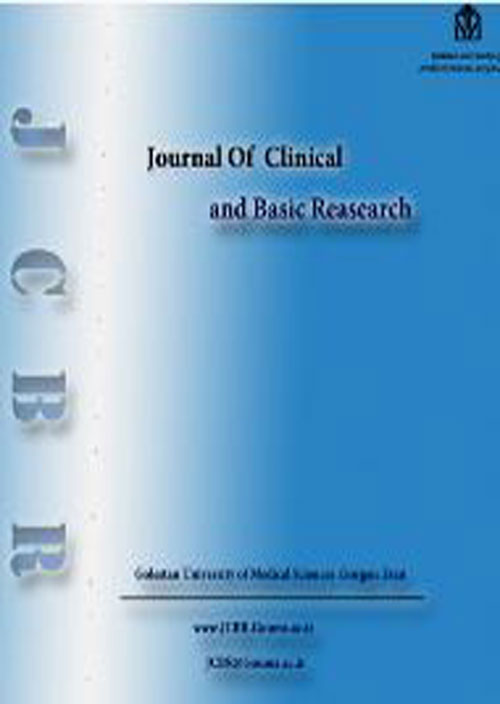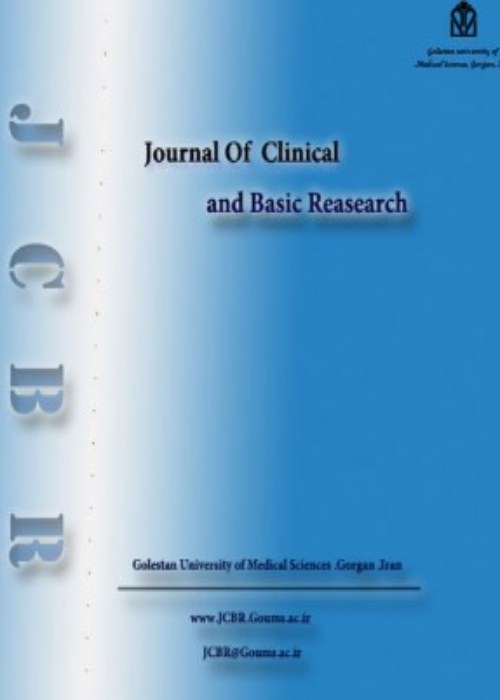فهرست مطالب

Journal of Clinical and Basic Research
Volume:4 Issue: 3, Summer 2020
- تاریخ انتشار: 1399/09/24
- تعداد عناوین: 6
-
Pages 3-9Background and objectives
Low-risk and high-risk human papillomavirus (HPV) genotypes are the main cause of anogenital warts. The present study aimed to determine prevalence of HPV genotypes in patients with anogenital warts in Gorgan, northeast of Iran.
MethodsIn this cross-sectional study, 40 biopsy samples were taken from patients with anogenital warts in Gorgan, Iran. After DNA extraction, multiplex polymerase chain reaction was carried out for detecting HPV genotypes 54, 18, 16 and 6. Demographic characteristics of subjects including gender, age, education level, marital status, smoking and method of contraception were also collected. Data were analyzed in SPSS 16 software at statistical significance of 0.05.
ResultsThe mean age of male and female patients was 31.81±6.9 and 27.95±6.92 years, respectively. The frequency of HPV-6, HPV-16 and HPV-54 was 77%, 15% and 7.5%, respectively. In addition, HPV-18 was not detected in the collected specimens. Co-infection of HPV-54 with HPV-6 and HPV-16 was also observed in some cases. No significant association was found between HPV infection and age, gender, smocking, contraceptive method and education level.
ConclusionsSimilar to previous studies in Iran and other countries, HPV type 6 is the predominant cause of genital warts in Gorgan, Iran. Further studies with a larger study population are needed to explore the role of other contributors to HPV-induced genital warts.
Keywords: Genital wart, Condylomata acuminata, Human Papillomavirus -
Pages 10-14Background and objectives
Redox status can be defined as an increase in oxidant and/or a decrease in antioxidant capacities. There is limited information about the redox status of patients with hepatitis B virus (HBV) infection. Therefore, we aimed to evaluate the redox status of patients with HBV infection in Zahedan, Southeast of Iran.
MethodsThis study was carried out in 2019 on 25 HBV patients and 25 healthy individuals. The level of malondialdehyde (MDA) was measured as a marker of lipid peroxidation. Superoxide dismutase (SOD) activity was also measured. Data were analyzed using SPSS software (version 17) at significance of 0.05.
ResultsThe MDA level in patients (5.3 ± 2.511 n/ml) was significantly higher than in controls (3.48 ± 0.516 n/ml) (P <0.01). Moreover, SOD activity was significantly lower in HBV patients (125.05±55.545 n/μl) compared to healthy controls (271 ± 74.236 n/μl) (P<0.01).
ConclusionOur results show that patients with HBV infection have higher serum MDA level and lower SOD activity compared to healthy individuals. This can cause liver damage and aggravate the complications in hepatitis B patients.
Keywords: Redox status, hepatitis B, malondialdehyde, superoxide dismutase -
Pages 15-28Background and objectives
Severe acute respiratory syndrome coronavirus 2 (SARS-CoV-2) is the seventh member of the coronavirus family to infect humans. The coronavirus disease was first identified in late 2019 in Wuhan, China. More than five million people in different countries have been infected with the virus in a matter of months. Although many studies have been done on the molecular immune pathogenesis and genetics of SARS-CoV-2, there is still not enough information about the virus. The purpose of this study is to summarize the latest information on SARS-CoV-2 characteristics, transmission, prevention and management to increase awareness and stop the virus transmission cycle.
ConclusionThe incidence of post-tonsillectomy hemorrhage, the methods for its management and the need for re-admission are quite different in different age groups.
Keywords: COVID-19, Corona virus, SARS-CoV-2 -
Pages 29-33Background
Hypertensive disorders of pregnancy are one of the most important and controversial unresolved issues in obstetrics. These disorders are one of the leading causes of maternal morbidity and mortality. Clinical manifestations of severe preeclampsia include severe headache, blurred vision, epigastric pain, hypertension and severe edema. The key to treating preeclampsia and vision disorders is controlling blood pressure, preventing seizures and labor induction. We herein report a case of preeclamspia with hypertensive chorioretinopathy.
Case descriptionA 23-year-old, G2P1L1, 35-week pregnant woman was presented with complaints of headache, dizziness, blurred vision in the left eye, lower extremity edema and less severe generalized edema. The patient was hospitalized with diagnosis of severe preeclampsia after further investigations. Given that the patient was not in the delivery stage, labor induction via cesarean section was carried out. The patient was then hospitalized in the coronary care unit for 24 hours and was later transferred to the gynecology ward. At day four of hospitalization, the patient fully recovered and was discharged.
ConclusionHeadaches and vision problems are common complains of most women with severe preeclampsia and eclampsia, which require immediate attention of obstetricians and midwives. It is recommended to immediately refer mothers with severe symptoms to a center equipped with intensive care for proper management of the maternal and fetal complications of preeclampsia
Keywords: Preeclampsia, Hypertension, Chorioretinopathy, Delivery -
Pages 34-39Background and objectives
Schizophrenia is a debilitating mental disorder characterized by disruptions in thought processes, perceptions, emotional responsiveness, and social interactions. Zinc is a neuroactive element released in synapses during neuronal activity and is required for proper functioning of the nervous system, particularly the brain. Serum and tissue concentrations of zinc may reflect various physiological and pathophysiological conditions. Evidence suggests a link between zinc level and development of schizophrenia. The aim of this study was to compare serum zinc levels between patients with schizophrenia and healthy individuals.
MethodsThis case-control study was performed on 55 patients (37 men and 18 women) with schizophrenia who were hospitalized in 5 Azar Hospital in Gorgan (Iran) and 55 healthy individuals. The case subjects were selected based on convenience sampling method using the Positive and Negative Syndrome Scale (PANSS), while the control subjects were enrolled based on the General Health Questionnaire-28 (GHQ-28). The groups were matched in terms of age and gender. Serum concentration of zinc was measured using a commercial colorimetric assay kit (5-Br-PAPS method).
ResultsSerum zinc concentration did not differ significantly between the patients and the controls (P=0.93). In schizophrenic patients, there was a significant, negative correlation between age and serum zinc concentration (r=-0.298, P=0.027). In both patients and controls, serum zinc level was significantly higher in men than in women (P<0.05).
ConclusionBased on the results, it is recommended to pay more attention to the diet of patients with schizophrenia.
Keywords: Zinc, Schizophrenia, Trace elements, Mental disorder


